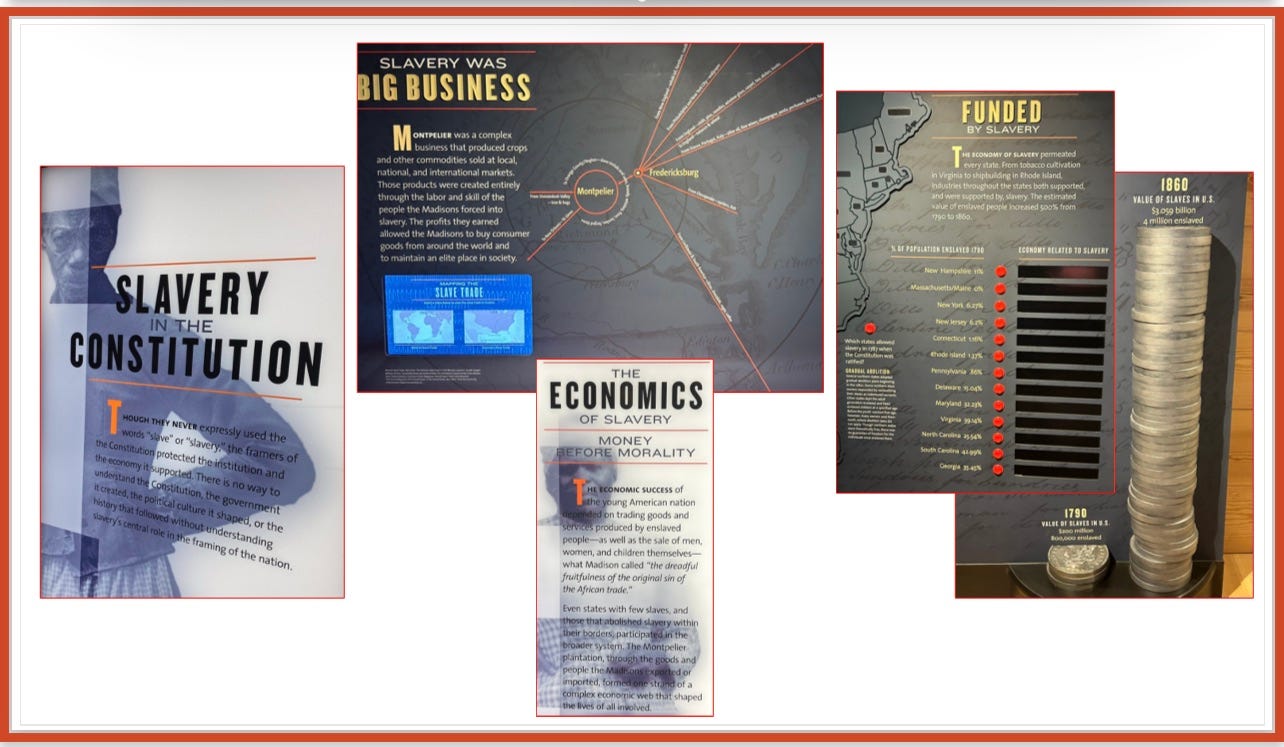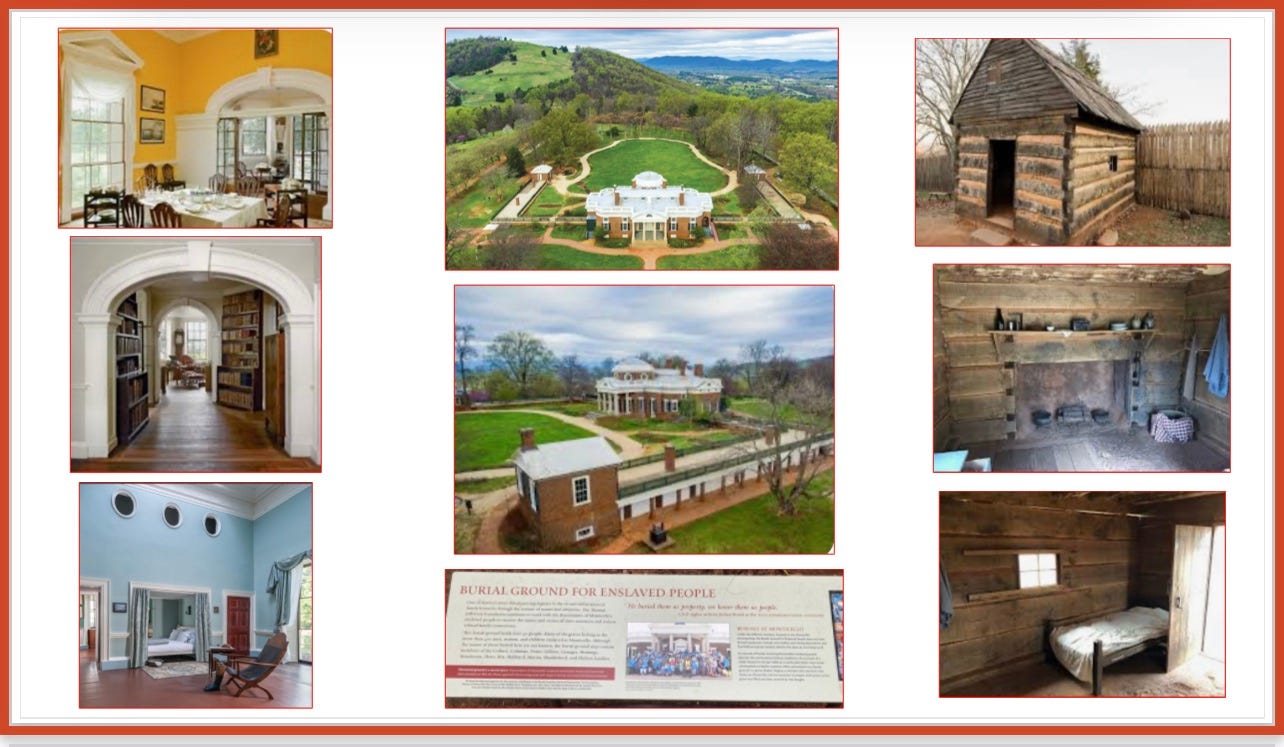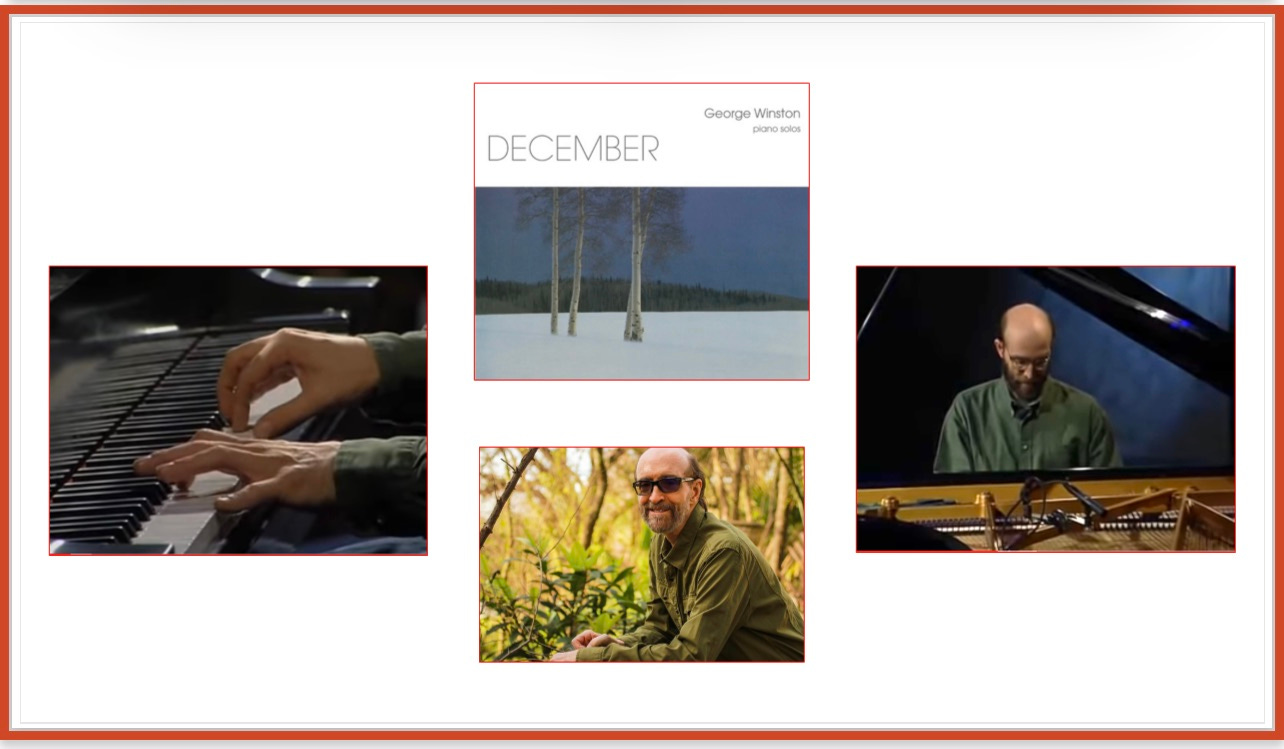Re-entry greetings, from that immersion pilgrimage to history-steeped Charlottesville!

Three iconic destination sites in mid-transformation, reunion time with friends and trip content well-aligned with newShrink themes were all as anticipated.
Of surprise not in the plan or personally imagined: The trip wielded emotional wallops, packed the kind of gut-punches that reverberate viscerally for days.
These started — so I will, here — with the drive up along that incredibly beautiful, to me always oddly back-in-time-uninhabited, stretch of Virginia mountain highway.
🔵
Some preface Southern thoughts, from a Southerner…
From that road-trip on came waves of long-forgotten memory and people. History and biography books once passionately pored-over. Previous visits lifetimes ago. Family ancestral roots not thought of in years. Even eerily familiar furnishings and glassware and fabrics and table-settings and colours. Oh, and the beautiful regional accents: Intelligent cadences with heart that rings true, no jarring discords of stereotpyed parody.
None of this exactly unpleasant. All just long off the radar, joltingly so.
It occurs to me that some of this looping back, and forward again with greater depth and scope, is precisely how history and memory work and are supposed to. Some metaphors I’m reminded of are Jung’s cycles of initiation/individuation… Dante’s terza rima rhyme scheme… Nabokov’s spirals from past to future… or the weaving of an Athena or Penelope in the language of myth.
Viewed that way, maybe it’s an apt personal mindset for this kind of travel experience. It describes rather literally the trajectory of today’s three historic sites in Charlottesville and other such re-imagined, deeper and broader re-takes on history and its peoples.
For just one example, in all three cases here earlier renditions of “history” had erased, physically hidden, then attempted comfortably appeasing-but-inaccurate incomplete truths. As with any kind of healing therapy, disruptive excavations literal and figurative are involved. In all three historic sites here, the prior obliteration and obfuscations were so total the original realities have required rebuilding — re-fabricating, more truthfully — to even hint at real day-to-day existence of the living humans under enslavement.
Also unusual on this trip more personally was a keen and constant awareness, one I almost never notice unless the topic is music or fiction: In this 6-some, as in many other groups of people I cherish, I’m the only “original-colonies/multigenerational” Southerner. It’s so common I seem usually to forget or not notice.
This is neither a feeling-left-out nor a know-more/they-don’t-get it thing. There’s simply a level at which I’m not only witnessing, observing and learning from arms-length. Instead all of these good AND bad AND ugly Southern contradictions, cultural dynamics, characters, and connections of history and association are also in me/mine. (Maybe this is similar for those whose roots are elsewhere, as when the history at hand and in focus is that of industrial-revolution era northeast or Rust Belt, for example.)
Through my adulthood, especially the last decade or so, and in graduate school on the west coast, so much about the South and Southerners is either or both an embarrassment or grossly misunderstood. Perhaps unconsciously distancing in response to that, I’m realizing I tend not to talk or even think about my own or much identify with “Southern-ness.” I find overt or exaggerated “Southernisms” of food, humor or dialect cringe-worthy. (Perhaps I’m not alone in this. I hope not. )
So it is odd and new to be so comfortably aware, even claiming, my own Southern-ness — right alongside this trip’s content focus on allowing in the very worst-of-the-worst truths about the most sacred of Southern cows.
Regarding Thomas Jefferson, in particular, I have long read much and been painfully clear-eyed while also still — in some ways more — revering of him and his legacies. It’s deeper and more personal too, maybe from my years with men and women in the psychotheray room, reading, or life experience. There’s a kind of sad, growing recognition of so much about the man beneath and beyond the varying talking points of different historic moments.
In newShrink terms Monticello, and Jefferson, present a comprehensive lens and case example for about every aspect of human slavery in the U.S. There’s first-draft journalism of the day and the system’s well-documented economic, historic, and political impacts even to the present. Some of the jaw-droppingly thorough, accessible scholarship of those adept with history, law and even science, is highlighted below and in source materials.
And psychologically, from the most rudimentary family-systems and trauma-focused psychotherapy to the depth psychodynamics of the unconscious soul, here is rich case material from which much can be studied, learned and applied for good. In glaring, elephant-in-the room focus is widower Jefferson’s 38-year shadow relationship and well-documented fathering of 4 surviving children with his enslaved chambermaid Sally Hemings from the time she was 14 years old. Thereafter no other known chidren were born to either of them.
Even a glance at the case’s therapy-entry type genogram is jarring. (A graphic of this appears in the linked Hemings Monticello exhibit below.) Hemings was the biracial half-sister of Jefferson’s deceased wife, Martha Wayles Skelton Jefferson. Jefferson had inherited both Sally and her house-maid mother Elizabeth from his father-in-law. Interestingly no portraits or even drawings of either of the two half-sisters have ever been found or displayed. However, there are many accounts and pictures of other striking physical family- and later Hemings-descendant resemblances throughout the Monticello tour exhibits.
Pondering all of this, while standing in Jefferson’s Monticello bedchamber, it’s impossible not to notice viscerally how small and intimate such households were. (Nobody is that quiet!) How this all felt, to enslaved children unacknowledged in such households, is well documented in published memoir accounts from Hemings’ son Madison and others.
The Sally Hemings exhibit (linked below in the Monticello section) cites prolifically astute diarist Mary Boykin Chesnut of the later slavery period in South Carolina, ca 1861. In classic unfiltered Chesnut form she describes how these agonizing truths in close family quarters were managed by white wives and households of the Boykin and Jefferson slaveholder classes (of different generations of the long US slavery era):
“...the mulattoes one sees in every family exactly resemble the white children— and every lady tells you who is the father of all the mulatto children in everybody’s household, but those in her own she seems to think drop from the clouds...”
(Chesnut and her famed Civil War Diary were the subject of the September 24, 2021 newShrink.)
All a powerful case for ever-increasing awareness, more consciousness— not wars on woke.
With Jefferson and others, to the obvious questions of rape and consent, raised often and loudly here, we’d best not apply #MeToo-era 21st Century standards too zealously. While certainly better off than slaves, regardless of color women, too, were the legal property of the men in their lives, could not own or inherit property, and for married women there was no such thing as consent to sex. (Similarly, and even quite recently in many states, a charge or prosecution of rape by a husband against his wife was legally impossible.)
More gnarly and difficult even to find language for discussion are the many overlaps of economics, morality, the very definitions of family and familial responsibility, and much more when human beings are also owned-property quite literally used for investment, expansion, protection and inheritance of wealth. In such relentlessly racist, misogynistic systems white men have undeniably created and perpetuate their relative power and wealth.
But in often-tragic paradox then and now, once created such closed systems also entrap, can bring misery and ruin even on those most powerful within them. In Jefferson and Madison’s time, and again in the post-Civil War South, many of these once-mighty wealthy slaveholding landowners were broke, indebted, their acknowledged white heirs — particularly the female ones — destitute. Today there are echoes of this in the desperation and backlash seen expressed by once-dominant white men unused to greater economic equity, political power and social freedoms of people of color and women.
Regarding the Jefferson-Hemings affair in today’s contexts, for me this Monticello project obliterates any remaining rationalizations or factual uncertainties. The thorough research by Harvard law- and history-professor, Pulitzer and National Book Award winner Annette Gordon-Reed, Jon Meacham and other historians, along with tracking and deep involvement by descendents of the enslaved are stunning and impressive at all three sites visited, but especially Monticello.
To my own surprise, this painful deep-dive has engaged me more, not less, in wanting to read, learn and in some way conribute to progress. As a Southerner!
Coming soon: Our 2 1/2-hour Slavery to Freedom tour there was guided by thoughtful and quietly powerful Sam, a retired engineer and native Virginian from Fredericksburg. He impressed, moved and seemed so familiar to me that I’ll be saying more about him. His kind of exhibited healthy masculinity (even in the South) features in next week’s Father’s Day edition.
🔵
Next up, an illustrated overview of some of the most relevant literature past and present, a children’s book for grand Miz E and even one haunting recent fictional take on Jefferson’s and Hemings’ inner lives. The tableau at center depicts my current summer daydream audio reading road-trip. (I adore driving, and told a friend I’d love to hit the road with Audible and return when all of these are finished, in some cases re-visited. Haven’t worked out such snags as not being able to take notes while listening, or that all works aren’t on Audible. It is a daydream not a plan!)
At center of the table-top photo — and as it turns out, a central predecessor to the award-winning Gordon-Reed work on Monticello — is a newly introduced version of a much-dog-eared favorite of mine, a then-controversial Thomas Jefferson biography. By the early 80s I had pored-over, read, reread and talked about it so much the marked-up paperback has long since vanished from my shelves. (In retrospect think I was a pretty strange 20- and 30-something.) Today I realize it was an early newShrinking work of journalism, scholarship and psychology. The author was a first female tenured professor of history at UCLA, a milestone she had in common with her contemporary teaching at Columbia law school, the late Justice Ruth Bader Ginsberg.
Just beginning the new edition, with an introduction added by Annette Gordon-Reed, I’m now thinking of this entire Monticello experience under some such header as “The Vindication of Fawn Brodie.” This, from Gordon-Reed:
Make no mistake: Thomas Jefferson: An Intimate History is a masterpiece. The test for that designation is not that a work is without flaws or that the author/creator gets everything exactly right — although Brodie got Thomas Jefferson the man almost exactly right. The most pedestrian of works can do that when nothing daring or especially useful is attempted. Instead, one sees in a masterpiece the product of a courageous, first-rate, creative and disciplined mind, a curious intellect, a large and wise soul — preferably all these things together — asking the right questions, grappling with them, answering most of them in the right way, in a sincere attempt to get as close to reality, truth and beauty as is possible within the limts of human imagination and capacity. Masterpieces completely change the nature of the conversaion in a given area. Brodie’s Thomas Jefferson meets all these criteria…
[With Jefferson] Brodie wanted to bring the private and public together to show the whole man — neither angel nor devil — but extraordinary and indispensable nevertheless. One wishes she had lived long enough to see her ultimate success in doing this.
Gordon-Reed, far from a lightweight herself, isn’t a Jungian — but could be.
Now to the highlighted overview of all three sites, abbreviated for time and energy limits. In the lede illustration opening this post:
At center is entry to the University of Virginia campus with statue of (much smaller) Thomas Jefferson atop a replica of the Liberty Bell. Jefferson modeled the storied UVA Rotunda in the background on the Roman Pantheon. At bottom center is the night-lit new memorial to multiple generations of some 4,000 enslaved laborers. Among them were the many who built, then worked in obscure basements and hidden behind stone walls, at Jefferson-created, architecturally magnificent UVA. At left are images of James Madison and his Montpelier Plantation, his childhood family home where he and his popular wife and former US First Lady Dolley Madison lived before and after his presidency. At right is Jefferson’s other architectural masterpiece, Monticello. All three above sites only recently began to exhibit and continue to engage descendants of those enslaved there. They aim to tell, show and animate our history for all that is truthful, whole and inclusive.
# 1. James and Dolley Madison’s Montpelier
Mellon Foundation Grants $5.8 million to memorialize/Montpelier (Montpelier.org)
The mere distinction of colour exhibit at Montpelier
Economics of a closed racist — and profoundly sexist — system
Not far from Madison’s family home from boyhood at Montpelier is the Charlottesville area site of his lifelong close friend from boyhood, Thomas Jefferson. Monticello was the realized vision of creatively brilliant philosopher-statesman Jefferson. There’s ample reason biographers have long dubbed him the sage of Monticello,
#2. Monticello, Jefferson’s utopian “little mountain”
Here’s a little back-story for context in recent-years’ news and political environment.
Monticello Is Done Avoiding Jefferson’s Relationship With Sally Hemings (New York Times, June 16, 2018)
A new exhibit grapples with the reality of slavery and deals a final blow to two centuries of ignoring or covering up what amounted to an open secret.
The following excellent links are productions from the Monticello Sally Hemings room exhibit. The best — and a quick and thorough read and viewing — is this first unabridged one.
Daughter, mother, sister, aunt. Inherited as property. Seamstress. World traveler. Enslaved woman. Concubine. Negotiator. Liberator. Mystery.
Sally Hemings (1773-1835) is one of the most famous—and least known—African American women in U.S. history. For more than 200 years, her name has been linked to Thomas Jefferson as his “concubine,” obscuring the facts of her life and her identity. Scroll down to learn more about this intriguing American…
This scaled-down summary version has a thorough bibliography.
Thomas Jefferson and Sally Hemings: A Brief Account
🔵
Now to downtown Charlottesville and UVA. Perhaps like many I found it hard to stand in front of St. Paul’s Episcopal Church on a hot Friday night without envisioning tiki-torch-bearing khaki-clad mobs of white guys and hearing echoes of “Jews will not replace us,” “Blood and soil,” or “Russia is our friend.”
Also unforgettable, the then-president’s wince-inducing minimization via “fine people on both sides” of the ensuing violence in which a young woman was killed.
Here, also, was President Biden’s stated impetus for entering his “battle for the soul of America” 2020 campaign for president.
The following August 2020 New York Times critic’s review provides much perspective with an excllent photo-story.
#3. Turning Grief for a Hidden Past Into a Healing Space
(NYT)
The University of Virginia in Charlottesville, designed by Thomas Jefferson, was built by enslaved people. The Memorial to Enslaved Laborers acknowledges that long-suppressed history.
Two pieces for context:
The Charlottesville rally 5 years later: 'It's what you're still trying to forget' (NPR, August 2022)
The Statue at the Center of Charlottesville’s Storm (The New York Times, August 13, 2017)
Since white nationalists marched Friday in Charlottesville, Va., the quiet college town has seen a nighttime brawl lit up by torches and smartphones, and worse violence that left one person dead and dozens injured.
At the center of the chaos is a statue memorializing Robert E. Lee. It depicts the Confederacy’s top general, larger than life, astride a horse, both green with oxidation.
The white nationalists were in Charlottesville to protest the city’s plan to remove that statue, and counterdemonstrators were there to oppose them.
🔵
Future editions and thought (maybe over years!) will pull up and explore elements mentioned today. For me there’s no end in sight to the needed theme of hope, healing path and continuous learning as salve and antidote to many most troubling trends in the news, events and public people of today’s America. Who knew how heartwarmed and choked-up one can be, just seeing busloads of early-summer school kids, big batches of white adults in Texas tee-shirts? Or wanting to hug the lines of middle aged white people traveling to pay a not-insubstantial fee in a freak-chilly June drizzle… to be made uncomfortable, to learn better and more, just maybe to do better.
School kids and grown-ups dig for artifacts at Montpelier’s slave quarters re-excavations. Continued such forward-looking, hopeful efforts like these are in different stages of process at Montgomery, Selma, Whitney plantation to name a few. In today’s world one wonders if private support and participation in such projects will have to provide what neither strapped public schools nor idealogically distorting private ones no longer will. (All of which has my late teacher-educator ancestors creating graveyard earthquakes.)
🔵
With today’s closing I leave you with bittersweet mix. There’s loss…
George Winston, the Quiet Giant of Solo Piano Music, Dead at 73 (Rolling Stone)
The musician, who sold over 15 million records during his career, had been battling cancer for 10 years.
…. and the most joyous of ways to start a day:
And, that is all I have! Talk to you next week.
🦋💙 tish
•🌀🔵🔷🦋💙
… it is important that awake people be awake,
or a breaking line may discourage them back to sleep;
the signals we give — yes or no, or maybe —
should be clear: the darkness around us is deep.
— William Stafford, “A Ritual to Read to Each Other”










